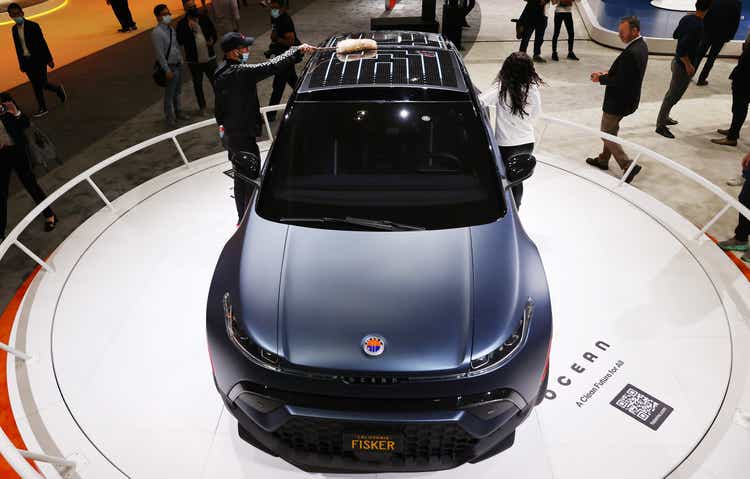Mario Tama
Fisker (NYSE:FSR) is close to the moment it has been working towards for years with the production of the Ocean SUV set to start within two weeks. Ocean now has 62,000 reservations, up from 56,000 in August as EV adoption continues to experience its time in the sun. That such a young company has come to amass a sales pipeline in excess of $2.3 billion is a strong vote of confidence in the company’s leadership under founder CEO Henrik Fisker. The asset-light model that outsources Ocean’s manufacturing to Magna’s (MGA) plant in Austria has also meant Fisker’s large liquidity position has remained relatively robust at a time when capital market conditions have become extremely discombobulated.
Ocean also has a number of features that set it apart from the crowded field. The SolarSky roof allows its owners to harvest sunshine to generate free energy at zero incremental cost. Fisker expects this to be able to produce up to 1,500 clean, emissions-free miles per year. Further, with the current cost per KWh in the US at around $0.16 this would mean annual savings of approximately $240 under the right weather conditions. This had been explored by other automakers including Tesla (TSLA) who wanted to develop a solar roof option for the Model 3 but Elon eventually walked back on the idea after concluding that the maths for putting solar panels on vehicles does not work out. Fisker has made it work and the unique feature is likely to be mirrored by other automakers.
The Ocean also comes with bidirectional charging which allows it to feed electricity back from its battery to the grid, homes or other vehicles. It essentially acts as a multi-function mobile power source allowing homeowners to use their car to run their home for up to seven days under emergency conditions. Bidirectional charging is a material use case for EVs as it not only helps garner greater resiliency for homeowners during extreme weather events like Hurricane Ian but also allows them to make money. This can be as much as $400 per year in countries where electricity prices vary throughout the day.
Fisker Ocean Is Set To Enter Production On 17th November
With the Start of Production set for November the 17th, Fisker stands at the cusp of realizing its EV dream. It would mark a milestone in a long journey to commercialization that really started 15 years ago in 2007 with Fisker’s predecessor Fisker Automotive. The 2020 SPAC phenomenon has truly acted as a salvo for the company, not only allowing Fisker to raise around a billion dollars but elevating its visibility to the retail masses.
The earnings for its last reported quarter were broadly inconsequential in the sense that they precede its product hitting the market. But shareholders were pleased to see the company exiting the quarter with cash and equivalents of $829 million against cash burn from operations of $86 million and capital expenditure of $57.3 million. The company brought in $116 million from its $350 million at the market equity program which forms a smaller part of a $2 billion shelf filed with the SEC. Prudent management of this position as manufacturing starts within two weeks will be key as current capital market conditions continue to disrupt the opportunities for the company to use its shelf to its full potential.
Fisker also updated on the Pear, a planned second model that is planned for a 2024 SoP. The company has over 5,000 reservations for the Pear which is set to be built by Foxconn in the former Lordstown Motors factory in Lordstown, Ohio.
EV Dream Reaches Fever Pitch
The Ocean SoP will initially be for a limited number of units with the production of the lower-priced sport version set to start in the second half of 2023. The company plans to phase its ramp with Magna throughout the next year. Management also floated potential US-based production of the Ocean from 2024 but these plans still seemed high level. However, the $7,500 tax credit will still apply to most of their vehicles as the company pushed reservation holders to retain the tax credit by converting their reservations into binding sales contracts.
Ocean’s unique features also don’t stop with its self-charging roof and bidirectional charging as the car will feature a range of eco-friendly materials from recycled plastic bottles, repurposed rubber waste, worn-out t-shirts and abandoned fishing nets pulled from the ocean. It’s clear that a material level of thought has gone into Ocean’s design. Against this, my inaugural coverage stating the company will find it difficult to stand out in an ocean of competition was out of step. This is likely to be one of the more viable EV plays on the market. I am not a buyer yet though as the macro backdrop still poses too much uncertainty.


Be the first to comment